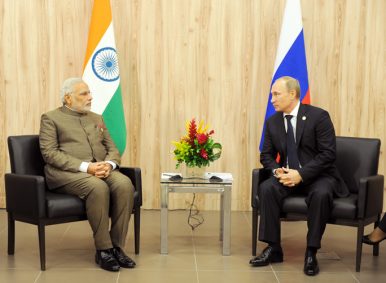By Rajeswari Pillai Rajagopalan
 Recently, India’s Foreign Secretary Vijay Gokhale, the most senior bureaucrat in India’s foreign ministry, completed a visit to Russia. The visit shed light on the ongoing collaboration between the two countries and the opportunities and challenges for the relationship.
Recently, India’s Foreign Secretary Vijay Gokhale, the most senior bureaucrat in India’s foreign ministry, completed a visit to Russia. The visit shed light on the ongoing collaboration between the two countries and the opportunities and challenges for the relationship.
Unsurprisingly, official accounts of the visit focused on areas of collaboration, most of it already ongoing. The Russian embassy release said that the two countries examined “cooperation within the BRICS format, the current issues of the key multilateral export control regimes, including New Delhi’s application for NSG [Nuclear Suppliers Group] membership, other non-proliferation and arms control issues, as well as topical international issues of mutual interest.”
The evolving situation in Afghanistan too was covered by the two leaders. The foreign secretary is reported to have also met Russian Deputy Foreign Minister Igor Morgulov for Foreign Office Consultations, where they “reviewed the implementation of the decisions of the 19th Annual Bilateral Summit” between Prime Minister Narendra Modi and President Vladimir Putin in 2018.
The two officials also discussed the upcoming high-level meetings, including India’s participation at the Eastern Economic Forum. Putin has reportedly invited India to participate in the Forum, which is to take place in Vladivostok in September this year.
Meanwhile, the Ministry of External Affairs press release on the visit characterized the meetings as “in-depth and productive, characteristic of the Special & Privileged Strategic Partnership between India and Russia.” The statement added, “The meetings resulted in enhanced mutual convergence and coordination of views on all major regional and international issues in the spirit of long standing and time-tested friendship between India and Russia.”
Despite the ongoing collaboration in these areas, the visit, and the official accounts of it, belie the mixed nature of actual ties. In fact, while India and Russia have had a long and warm relationship historically and Russia remains an important strategic partner (it is one of only two countries India has an annual bilateral summit with, the other being Japan), structural trends are pulling them in different directions.
Part of it has to do with perceptions on both sides. On India’s side, it can at times appear not to acknowledge the reality that Russia needs China far more than it needs India, and that its own diversification of partners in both the economic and security domains can also raise concerns in Moscow and complicate bilateral dealings. On Russia’s side, there is at times not enough of an appreciation for India’s strategic considerations, including its sensitivities toward China, as well as an acknowledgement that some of Moscow’s foreign policy activities can cause headaches in New Delhi.
But developments have also accelerated these perceptions as well. Russia’s adventurism abroad, including in Ukraine, China’s rise and its increasing convergence with Russia as it does so, rising U.S. competition with both Beijing and Moscow as it has gradually warmed to New Delhi, and upped conversation on the Indo-Pacific and the divergent approaches by India and Russia have all contributed to this.
Seen from this perspective, it is arguably even more important to have visits such as the one we saw from Gokhale, in order for both sides to understand each other. But at the same time, it is also critical to distinguish between the rhetoric that comes out of the visits and the reality of the relationship, especially when the gap between the two can seem to be growing wider in some senses.
No comments:
Post a Comment